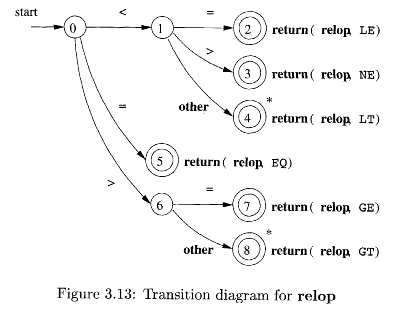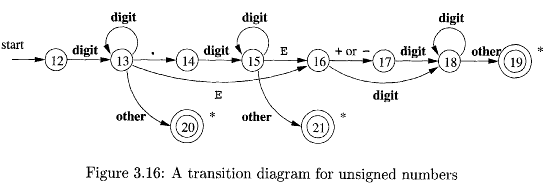02 Lexical Analysis
Also called as scanning
We specify tokens using Regular Expressions - sequence of characters specifying search pattern in input
We use NFA/DFA
Parts¶
| Meaning | Example | |
|---|---|---|
| Tokens | Pair containing token_name and attributetoken_name is a symbol representing a ‘lexical unit’, which is processed by parser | <id, pointer_to_symbol_table_entry> |
| Lexical Units | Identifiers, Keywords, Operators, Constants (numeric/string) | |
| Pattern | Rule describing the format of the lexemes of a token | For keywords it’s the sequence of characters itself |
| Lexeme | Sequence of characters that matches that pattern for a token | |
| Sentinals | Special characters that cannot be part of the source program | eof character can be used to denote the end of a buffer |
Example¶
<id, pointer_to_symbol_table_entry_for_e>
<assign_op>
<id, pointer_to_symbol_table_entry_for_m>
<mult_op>
<id, pointer_to_symbol_table_entry_for_c>
<exp_op>
<number, 2>
Input Buffering¶
In Fortran, spaces are ignored. So, he l lo is the hello. This is because, there may exist blank instances in the magnetic tape.
We can’t tell if the statement do 5 i = 1.25 is to be treated as
until we reach the .
Fortran Loops¶
do index_variable = start, end, step
statements
end do
// or
do n index_variable = start, end, step
statements
n continue
Lookahead¶
Lookahead of atleast one/more characters beyond the next lexeme before we can be sure that we have the right lexeme.
Helps speed up reading source program
We usually use 2 buffer scheme lookahead, which are alternatively-reloaded; each buffer is of the same size \(n\), where \(n\) is size of a disk block
Advantages¶
- Using one system read command we can read \(n\) characters into a buffer, rather than using one system call per character
- A special character, represented by eof (character different from any possible character of source code), marks the end of the source file
2 Buffer Scheme¶
| Pointer | Purpose |
|---|---|
lexeme_begin | marks the beginning of the current lexeme, whose extent we are attempting to determine |
forward | scans ahead until a pattern match is found |
When the next lexeme is determined, the following steps are taken:
forwardis set to the character at its right end- Record the lexeme as the attribute of the token
lexemeBeginis set to the character immediately after the lexeme just found

Advancing forward requires checking if end of a buffer is reached.
forward is at end of buffer | - Reload other buffer from input - Move forward to beginning of newly loaded buffer |
eof character at the middle of buffer | - marks the end of the input - terminate lexical analysis |
Recovery Strategies¶
Recovery strategies are used when no pattern for tokens matches any prefix of remaining input, preventing lexical analyzer from proceeding
Goal: Transform prefix of remaining input into valid lexeme
Possible error-recovery actions are:
- Panic Mode Recovery: Delete successive characters from the remaining input, until the lexical analyzer can find a well-formed token at the beginning of what input is left
- Insert a missing character into the remaining input
- Replace a character by another character
- Transpose two adjacent characters
Parts of String¶
| Term | Meaning | Example \(s =\) banana |
|---|---|---|
| Prefix | Starting character(s) | \(\epsilon\), b, ba, ban, bana, banan, banana |
| Suffix | Trailing character(s) | \(\epsilon\), a, an, ana, nana, anana, banana |
| Substring | Middle character(s) | prefix_set \(\cup\) suffix_set |
| Proper Prefix | Non-empty prefix \(\ne\) original string | b, ba, ban, bana, banan |
| Proper Suffix | Non-empty suffix \(\ne\) original string | a, an, ana, nana, anana |
| Proper Substring | Non-empty substring \(\ne\) original string | proper_prefix_set \(\cup\) proper_suffix_set |
| Subsequence | Collection of characters of string (not necessarily contiguous, but left \(\to\) right) | baaa (too many combinations to list out) |
Operations¶
In order of precedence
| Operation | Operator | |
|---|---|---|
| Strings | Exponentiation | \(s^i\) |
| Concatenation | \(s_1 \cdot s_2\) | |
| Languages | Kleene closure | \(L^*\) |
| Posive closure | \(L^+\) | |
| Concatenation | \(L_1 \cdot L_2\) | |
| Union | \(L_1\) \vert \(L_2\) \(L_1 \cup L_2\) |
Regular Definitions¶
Helps to give names to regular expressions and use those names in subsequent expressions
where
- \(d_i\) is a new symbol, such that
- \(d_i \not \in \epsilon\)
- \(d_i \ne d_j\)
- \(r_i\) is a RE over alphabet \(\epsilon \cup \{d_1, \dots, d_{i-1} \}\)
Lex¶
Language that allows us to create our own lexical analyzer, without having handcode
It represents everything in terms of a Finite State Machine, and then generates the code
Lex Symbols¶
| Symbol | Meaning | Example |
|---|---|---|
| c | non-operator character c | |
| \c | character \(c\) literally | |
| “s” | string \(s\) literally | |
| . | any character except \n | hello \(\implies 5 \ .\) |
| ^ | beginning of line | ^abc |
| $ | end of line | abc$ |
| [s] | any character in \(s\) | \([abcde]\) $a |
| [^s] | any character not in \(s\) | \([\wedge abcde]\) $(a |
| r* | 0/more strings matching \(r\) | (something)* |
| r+ | 1/more strings matching \(r\) | (something)+ |
| r? | 0/1 strings matching \(r\) | (something)? |
| r{m,n} | \(\text{count} \in [m, n]\) strings matching \(r\) | (something){1, 5} |
| \(r_1r_2\) | \(r_1\) followed by \(r_2\) (select \(r_1\) and \(r_2\)) | |
| \(r_1/r_2\) | \(r_1\) followed by \(r_2\) (select only \(r_1\)) | |
| $r_1 | r_2$ | \(r_1\) or \(r_2\) |
| \((r)\) | Same as \(r\) | $(a |
Transition/State Diagrams¶
Reg Exprs are translated into transition diagrams (representing Finite State Machines), which are then translated into program code for lexical analyzer
Relational Operators¶

Reserved Words/Identifiers¶

Unsigned Numbers¶

Whitespace¶

Conflict Resolution¶
- Longer prefix preferred
- If there are multiple matches for longest prefix, first pattern in lex program is preffered